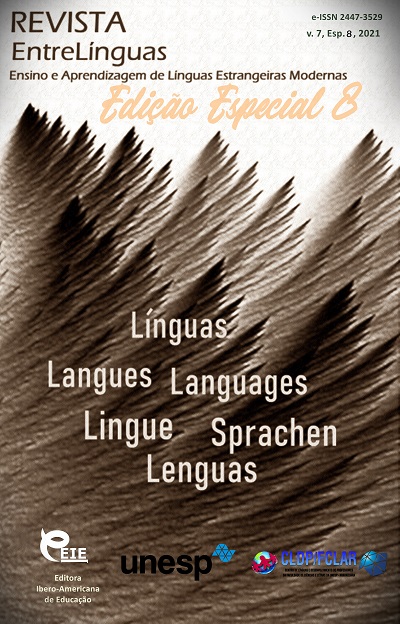The features of the organization of the process of teaching chinese students-philologists the homonym vocabulary of the russian language
DOI:
https://doi.org/10.29051/el.v7iesp.8.16369Keywords:
Chinese students-philologists, Homonyms, Homographs, Principles of training, Strategies of training, A set of exercisesAbstract
The article discusses the issues of teaching Chinese students - philologists the homonymous vocabulary of the Russian language. The authors propose a description of the organization of the process of teaching the homonymous vocabulary as a system, an analysis of its constituent elements and the relationships existing between them. The necessary set of skills and abilities is determined, allowing the individual to use correctly the homonyms of the Russian language in the process of communication, as well as the specific difficulties that Chinese students face in the process of studying the homonymous vocabulary. The article also formulates the basic principles of teaching Chinese students-philologists the homonyms of Russian language and describes a set of exercises. All provisions of the article are illustrated by examples. The material of such article was used in Philosophy and Social Science Planned Project of Heilongjiang Province (2020),The Practical Research of Cultivating the Compound Foreign Language Teachers in Heilongjiang Province from the Perspective View of ESP (20YYD218).
Downloads
References
Balykhina, T. M., Zhao Yujiang. 2009. What are they like, Chinese? Ethnomethodical aspects of teaching Russian lan- guage to the Chinese // Higher education today. No. 5. - P. 16–22. (In Russian)
Fan Y. 2020.The use of homonyms in teaching the Russian language Chinese students at the initial stage /Y. Fan, E. N. Tarasova // The professor of XXI century. - No. 1-1. - S. 175-181. - DOI 10.31862 / 2073- 9613-2020-1-175-181. (In Russian)
Guzarova N.I., Petrovskaya T.S. 2009. On the issue of improving the efficiency of adaptation of Chinese students to the academic and socio-cultural environment of Siberian University (based on the material of the Tomsk Polytechnic University) // Russian-Chinese linguistic ties and problems of anticivilization communication in the modern world: the materials of international, scientific-practical conf. (Omsk, 18-19 November 2009). Omsk: OmGPU.pp.26–29. (In Russian)
Ignatova, I.B. 1997. Teaching the grammatical structure of speech of foreign students-philologists as the basis for the formation of the lain accordance with the conditions of the speech situation, and personality of the future professor: dis. Dr. ped. Sciences/ I.B. Ignatova. SPb. -420p. (In Russian)
Ignatova, I.B. 2004. Communicative culture of the linguistic personality of students-philologists/IB Ignatova, SM Andreeva. Belgorod: BelGU Publishing House. -200p. (In Russian)
Ignatova, I.B. Linguo-methodical system of teaching the homonyms of the Russian language (anthropocentric approach) foreign students-philologists: monograph / Ignatov I., Kuleshova R. V.; Belgorod State un-t, Petrovskaya acad. Sciences and Arts (Belgorod branch), the Department of Russian language and intercultural communication. - St. Petersburg; Belgorod: Belgorod State University. - 214 p. (In Russian)
Ivanova M.A. 2001. Social and psychological adaptation of foreign students to the higher school of Russia: Dis. Dr. psychol. sciences. SPb. -353 p.
Kalmykov P.N. 2009.Chinese student youth in Moscow. Migration flow resource or Russian counterparties in China? // Bulletin of the Russian State University for the Humanities. - No. 2. - P. 234–250. (In Russian)
Kosheleva E.Yu. 2013. Ethnopsychology features of the model of teaching Chinese students / E. Yu. Kosheleva, Ya. Pak, E. Chernobilski // Modern problems of science and education. - No. 2. - P. 258. (In Russian)
Kovanova M. S. 2021. Interaction between Russia and China in the educational sphere / M. S. Kovanova. - Text: direct // Young scientist. - No. 1 (343). - S. 123-126. - URL: https://moluch.ru/archive/343/77201/ (date of access: June 29, 2021). (In Russian)
Shatilov S. F. 1985. Actual problems of teaching the Russian language foreign students / S. F. Shatilov. - L.: Leningrad State University. -153p.
Downloads
Published
How to Cite
Issue
Section
License

This work is licensed under a Creative Commons Attribution-NonCommercial-ShareAlike 4.0 International License.
Os manuscritos aceitos e publicados são de propriedade da Revista EntreLínguas. Os artigos publicados e as referências citadas na Revista EntreLínguas são de inteira responsabilidade de seus autores.
Transferência de direitos autorais – autorização para publicação
Caso o artigo submetido seja aprovado para publicação, já fica acordado que o(s) autor(es) autoriza(m) a UNESP a reproduzi-lo e publicá-lo na EntreLínguas, entendendo-se os termos “reprodução” e “publicação” conforme definição respectivamente dos incisos VI e I do artigo 5° da Lei 9610/98. O artigo poderá ser acessado pela rede mundial de computadores (Internet), sendo permitidas, a título gratuito, a consulta e a reprodução de exemplar do artigo para uso próprio de quem a consulta, desde que haja a citação ao texto consultado. Essa autorização de publicação 328 EntreLínguas, Araraquara, v. 1, n .2, p. 323-328, jul./dez. 2015 não tem limitação de tempo, ficando a UNESP responsável pela manutenção da identificação do(s) autor(es) do artigo. Os artigos publicados e as referências citadas na Revista EntreLínguas são de inteira responsabilidade de seus autores.











